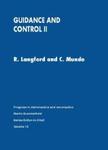版权所有:内蒙古大学图书馆 技术提供:维普资讯• 智图
内蒙古自治区呼和浩特市赛罕区大学西街235号 邮编: 010021

丛 书 名:Progress in Astronautics and Aeronautics
版本说明:1
I S B N:(纸本) 9781563478628
出 版 社:American Institute of Aeronautics and Astronautics
出 版 年:1964年
页 数:1013页
主 题 词:Aerodynamic Performance Aerodynamics Aeronautical Engineering Aeronautics Aerospace Electronics Aerospace Engineering Aerospace Sciences Aerothermodynamics Air Navigation Aircraft Components and Structure Aircraft Control Aircraft Design Aircraft Flight Control System Aircraft Instruments Aircraft Navigation Systems Aircraft Operations and Technology Aircraft Stability and Control Aircrew Airspeed Altitudes in Aviation Apollo Program Applied Mathematics Artificial Intelligence Astrodynamics Astronautics Astronomical Events Astronomical Observatory Astronomy Atmospheric Radiation Atmospheric Science Attitude Control Aviation Aviation Safety Avionics Avionics Computers Bearings (Mechanical) Boundary Element Method Celestial Coordinate System Celestial Mechanics Civil Aviation Commercial Aviation Computational Fluid Dynamics Computer Programming and Language Computing and Informatics Computing, Information, and Communication Continuum Mechanics Control Systems Control Theory Coordinate System Data Science Earth Sciences Electrodynamics Electromagnetic Radiation Electromagnetism Energy Energy Economics Energy Forms Energy Forms, Production and Conversion Entry, Descent and Landing Feedback Control Finite Element Method Flight Control Surfaces Flight Dynamics Flight Mechanics Flight Recorder Flight Test Fluid Dynamics Fluid Flow Properties Fuels General Physics Geometry Functions Geophysics Guidance, Navigation, and Control Systems Gyroscopes Human-Computer Interaction Human-Machine Interaction Inertial Measurement Unit Kalman Filter Kepler's Laws of Planetary Motion Magnetic Fields Magnetism Magnetometers Magnetostatics Materials and Structural Mechanics Mathematical Analysis Mechanical and Structural Vibrations Military Airbases Military Aviation Missile Systems, Dynamics and Technology Monte Carlo Method NASA NASA Facilities NASA Programs Navigation Instruments Navigational Guidance Non-Renewable Energy Nuclear Fuels Numerical Analysis Optimal Control Theory Orbital Maneuvers Orbital Property Permeability Planetary Science and Exploration Planets Satellite Guidance Satellites Semiconductor Devices Sensors Solar Physics Solar System Moons Solid Mechanics Space Agencies Space Exploration and Technology Space Flight Tracking and Data Network Space Missions Space Orbit Space Rendezvous Space Science and Technology Space Stations Space Systems and Vehicles Space Vehicle Spacecraft Attitude Control Spacecraft Design Spacecraft Guidance Spacecraft Guidance and Control Spacecraft System Spacecrafts Spectral Bands Spectroscopy Statistical Analysis Structural Design and Development Structural Engineering Structural Kinematics and Dynamics Structural Mechanics Structures, Design and Test Telescopes Terminal Velocity Thermal Measurement Thermocouples Thermodynamics Thermophysics and Heat Transfer Torsional Vibration Transducers Transistors Tribology and Bearing Design Vibration Control Vibration Measuring Instruments
摘 要:The present volume is intended both as a report on, and an authoritative reference guide to, the present status of the closely connected fields of Guidance and Control, particularly as related to missiles and space vehicles. Like its predecessor in the series, Volume 8, this volume had its genesis in a Specialist Conference that was held at the Massachusetts Institute of Technology in August 1963. Although in no sense a proceedings of this conference, the present volume uses the same subdivisions of technology, i.e., Attitude Control, Inertial Guidance, Onboard Techniques, Manned Control, Deep Space Guidance and Navigation, Rendezvous, and Landing. To set the stage and to orient those readers who may not have had exposure to the more rapidly growing areas, the Editors have invited certain introductory review articles. They will assist the reader s entry into the subject and into the literature, and in addition they contain information basic to the more complex situations covered in the succeeding papers. In the selection of papers the guiding rule has been the exposure of diverse lines of inquiry, with particular attention given to those current lines of research that appear to be most promising.